The Right Foot for Chewie: Weekly Updates
Navigation:
- The Right Foot for Chewie Homepage
- Weekly Updates (this page)
- Resources
- Mid-term Updates
- Final Presentation
On this page
- Weekly Update 1: Project Goals + Meeting 1
- Weekly Update 2: Competitive Analysis + Meeting 2
- Weekly Update 3 : Meeting 3 Collaborative Design Framework 1
- Weekly Update 4 : Student Team Meeting + Next Steps
- Weekly Update 5 : Meeting 4 Major Breakthrough
- Weekly Update 6 : New Project Goal: Accessible Saddle Bag
- Weekly Update 7: Meeting 5 Collablorative Design Framework 2
- Weekly Update 8 : Prototyping Updates
- Weekly Update 9: Final Presentation + Building Meeting 1 with Daniel
- Intermittent Update 1: Meeting 6 with Jessica
- Intermittent Update 2: Building Meeting 2 with Daniel
- Intermittent Update 3: Building Meeting 3 with Daniel
- Intermittent Update 4: Building Meeting 4-5 with Daniel
- Intermittent Update 5: Final Building Meeting 6 with Daniel
- Intermittent Update 6: Video feedback on usability from Jessica
- Intermittent Update 7: Meeting 7 with Jessica on Dissemination
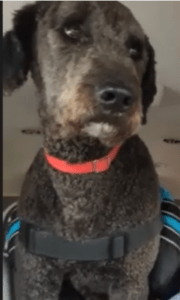
Intermittent Update 7: 10/31/23 (Meeting 7)
Meeting 7 with Jessica: 10.31.23
- Expressed their gratitude and satisfactory usability of the saddle bag
- They would like to market the bag on her website and partner to create more to make available for sale to those who may need it
- Outsource from a connection in the Philippines
- Possible funding through Jessica’s foundation
- Revisited idea of the of instruction manual to promote on her website and provide to tailors who may offer this service as a possible route
- Requested a video from beginning to end from Jessica
- Selena to follow up with team/Amy for upscaling of project
Intermittent update 6: 9/7/23 (Video Feedback)
- Received video of Jessica using bag after several months of consistent use
- General feedback:
- Slightly heavy, but to be expected because of the magnets
- Magnet works well for the tote bag and Jessica is seamlessly able to store and retrieve necessary items
- Hook falls off at seldomly but is able to pick it up with ease, and Jessica stores it after use
Intermittent update 5: 3/27/23 (meeting 6 with Daniel)
- Final assembly of bag
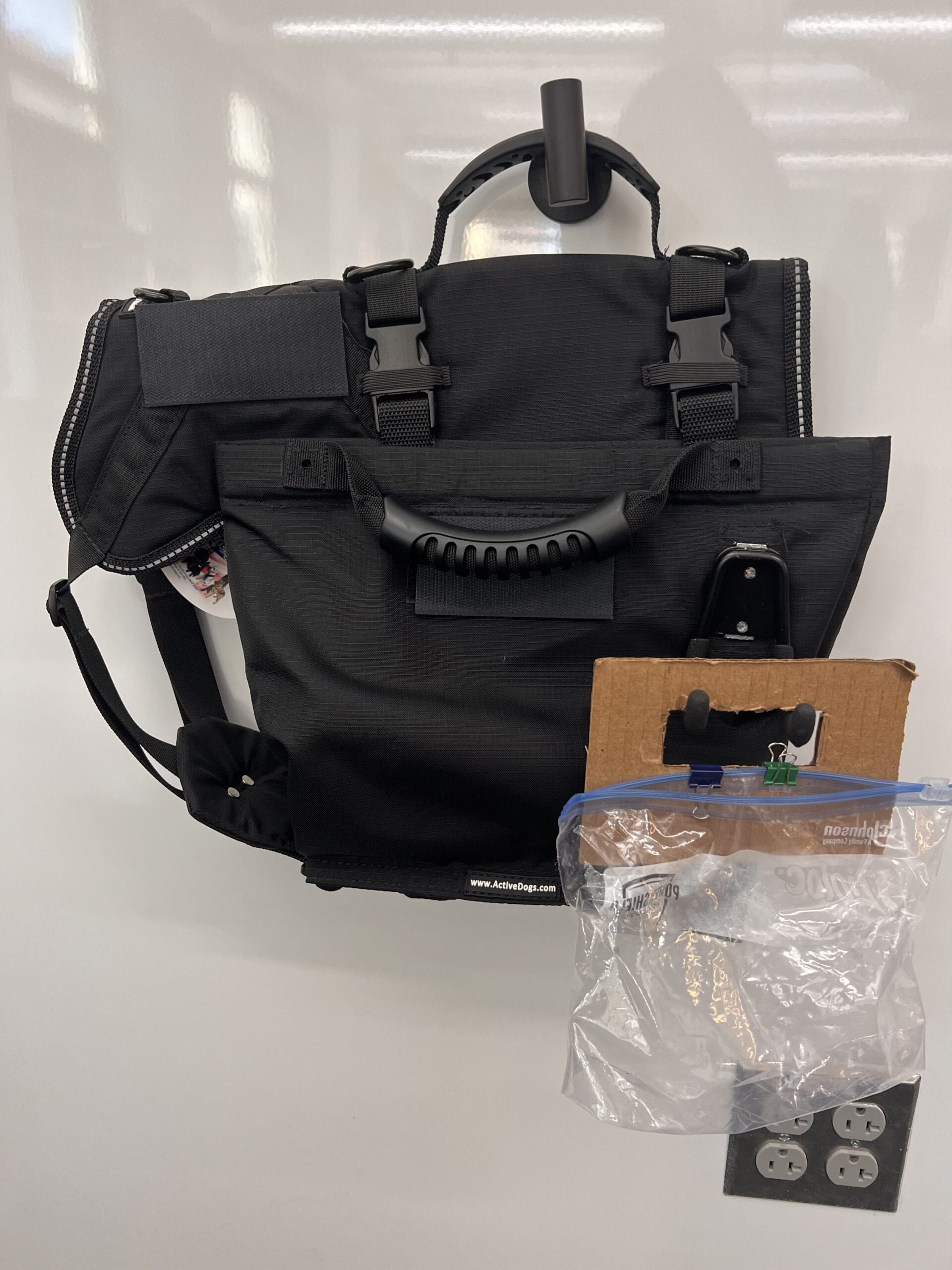
- Send and trial with Jessica
- Next steps
- Start instruction manual
- Receive feedback from Jessica
Intermittent Update 4: 2/16/23 (Meeting 4-5 with Daniel)
Selena’s FOURTH AND FIFTH Meeting with Daniel: 2.14.23 & 2.16.23
In these last two meetings with Daniel we were able to finish sewing in the magnets to the tote bags and adding the handles after many unforeseen hurdles! Below is a video of Selena testing out opening and closing the bags with her lower extremity on a dog. This dog is bigger than Chewie, so she was not able to buckle in the saddle, but it was held in place for stability.
Testing opening/closing adapted saddle bag on dog
After this meeting Selena weighed the saddle bag with the adaptations to ensure that the bag was well under the limit of 16lbs, which is 25% of Chewie’s weight. Addtitionally she did some test with the hook adaptation adaptation to find out how much weight it could handle without following. Below are pictures and videos of the demonstration.
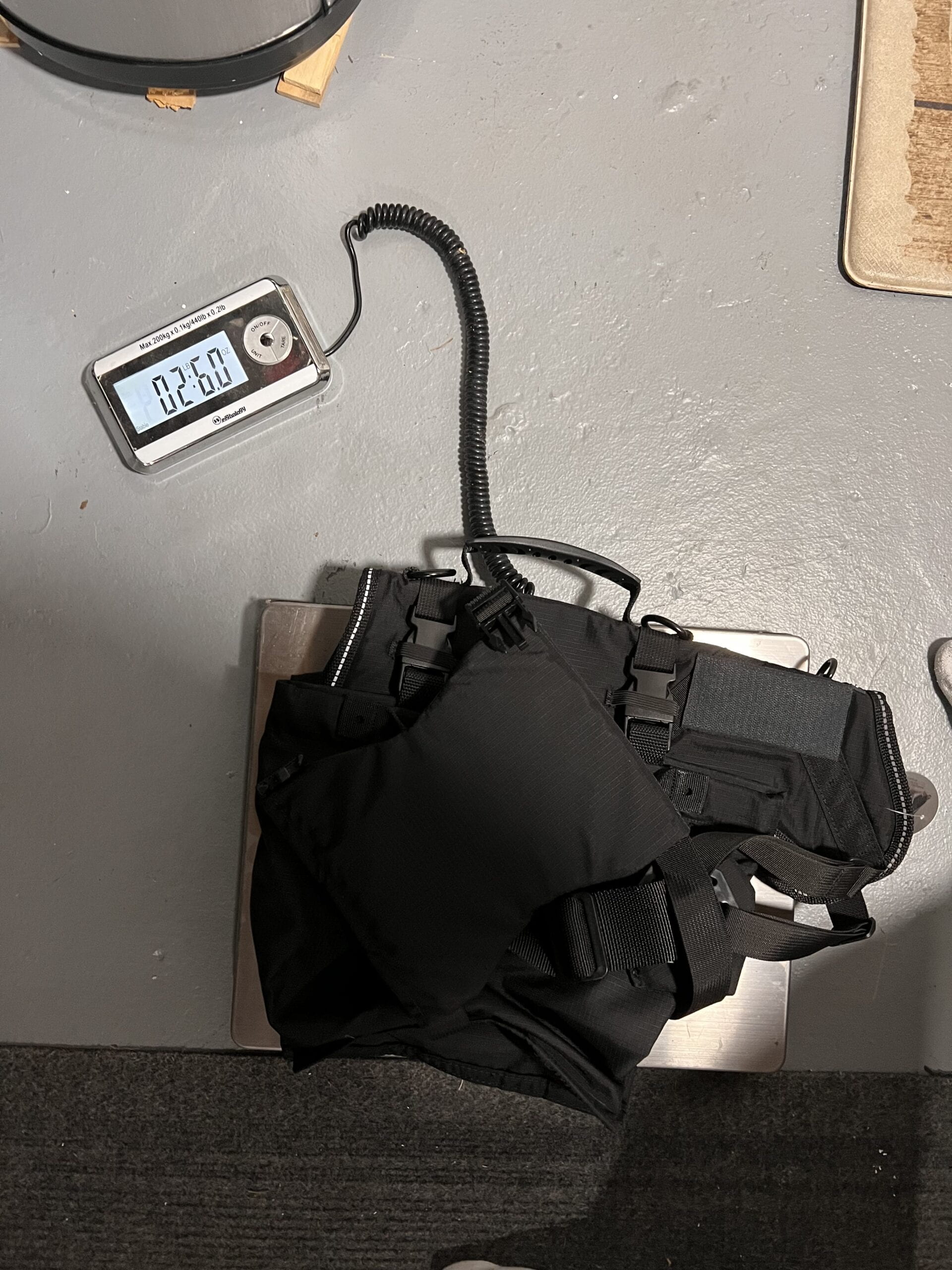
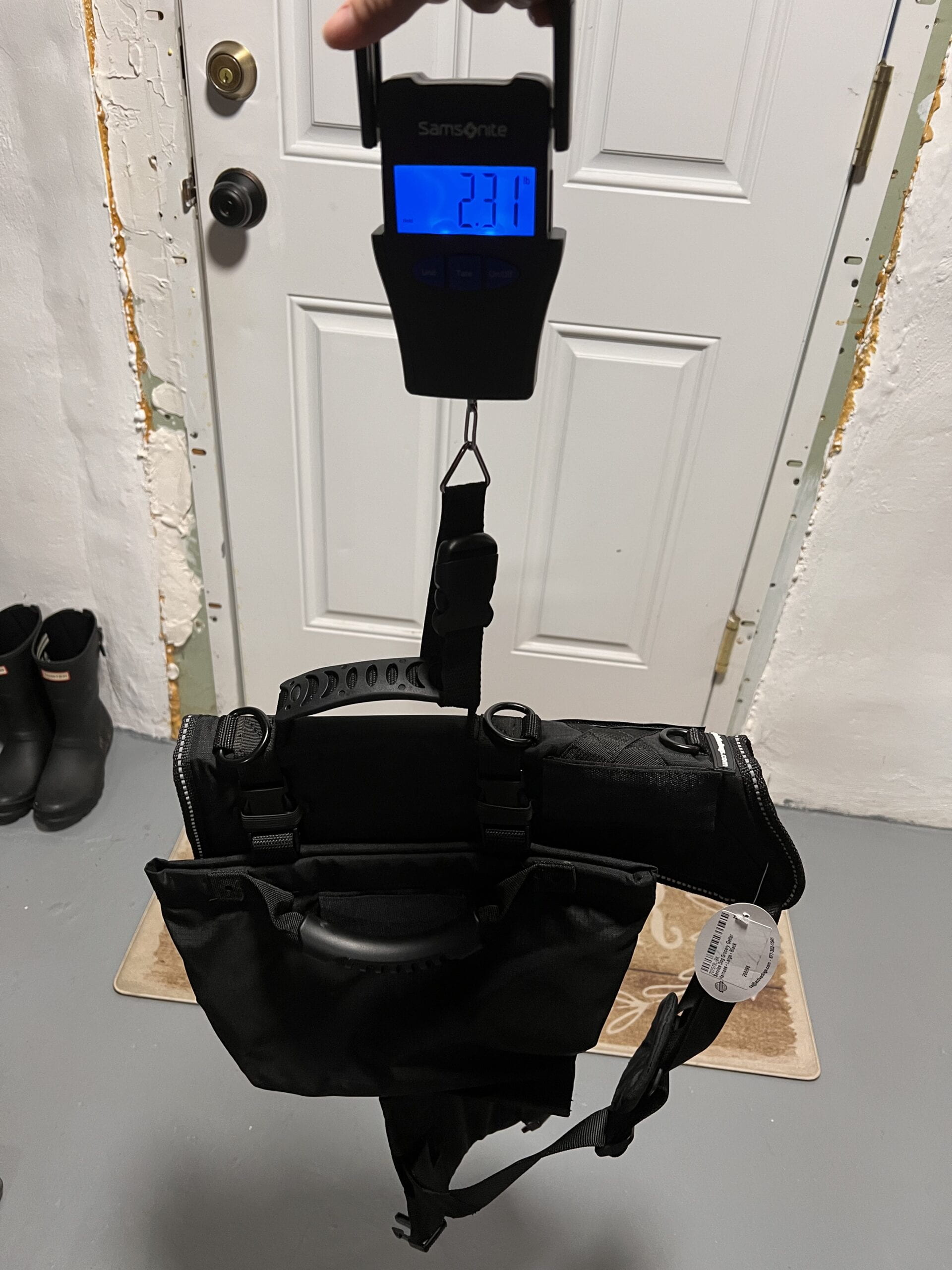
Based on the scales above the average weight of the adapted bag is 2.45 lbs.
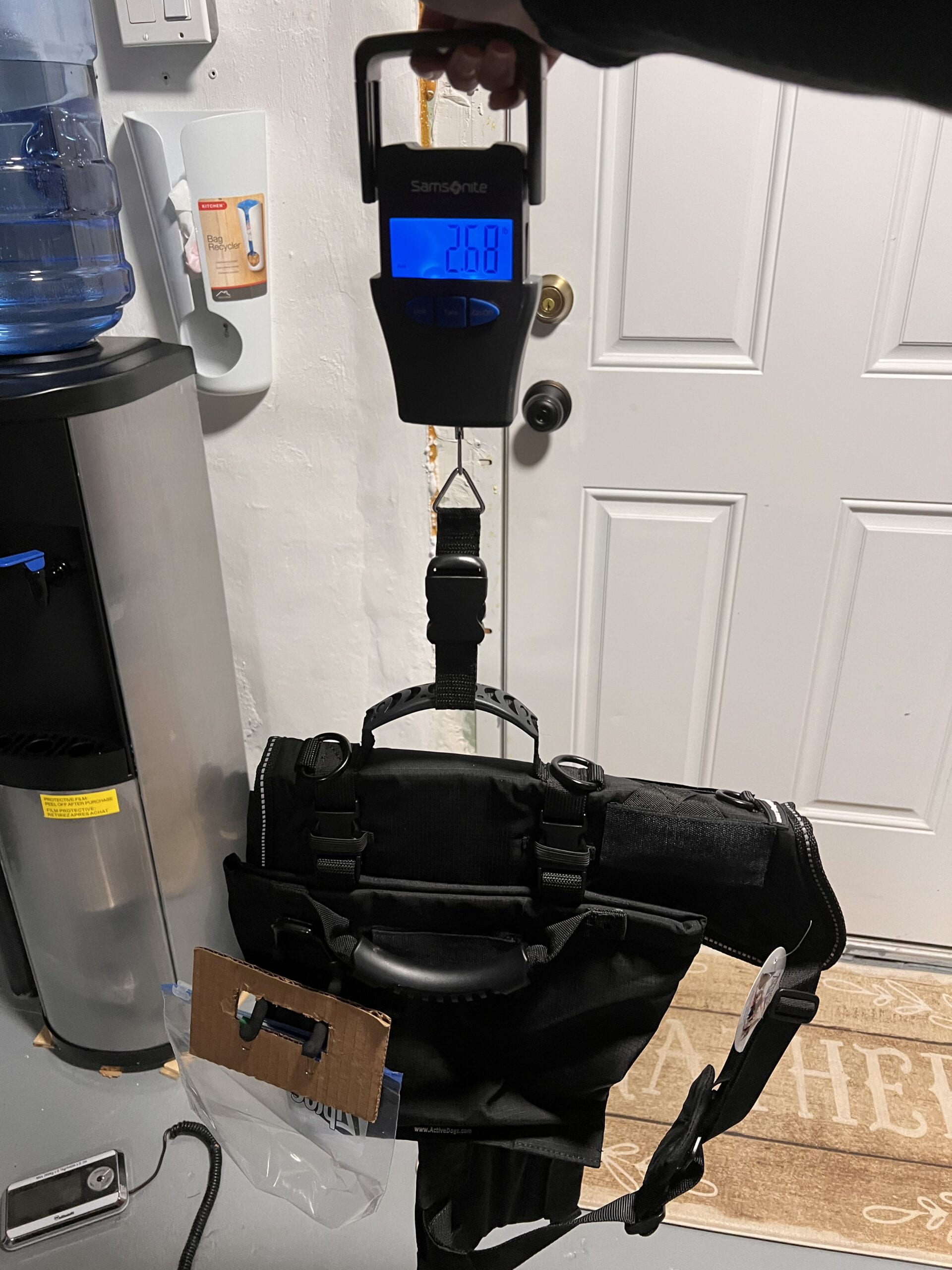
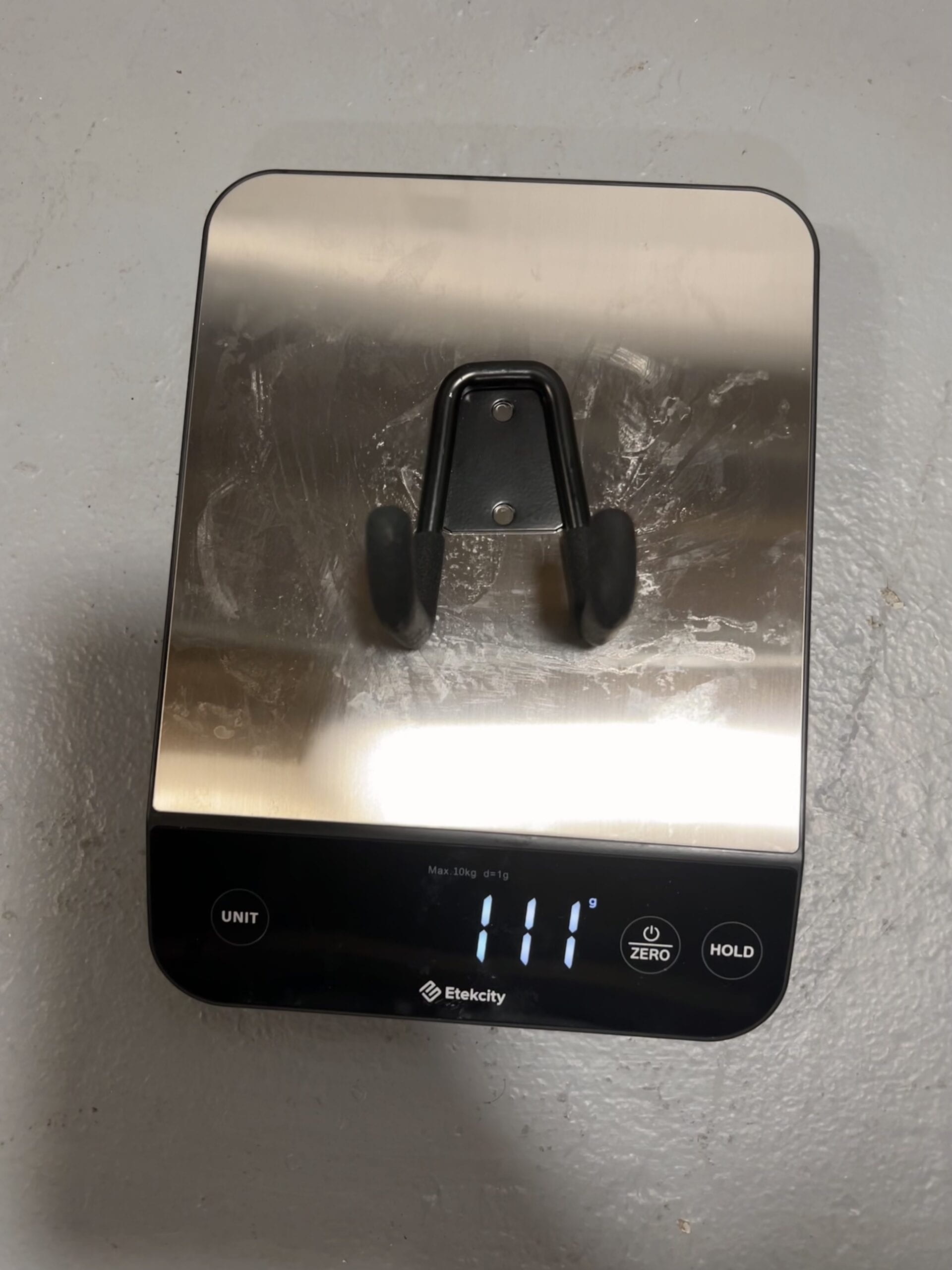
The black double pronged hook from Home Depot weighs 111 g = 0.25 lbs. The team along with Jessica needs to consider if this weight is acceptable or if a lighter alternative, or 3D printed solution is the way to go.
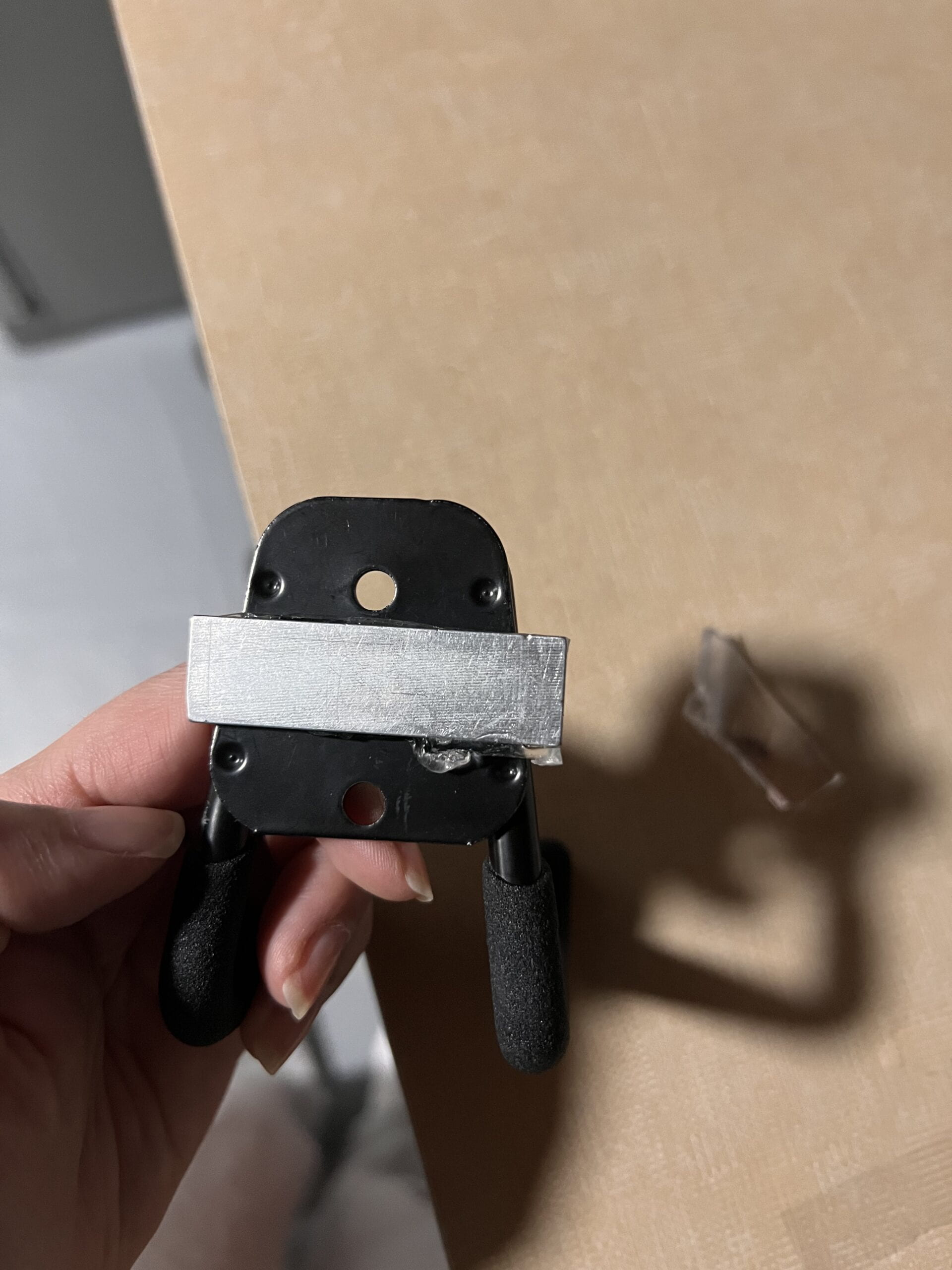
In order to test the manget’s strength, one magnet was temporarily attached to the back of the hook that will hold the mock dispoz-a-scoop using strong double sided tape. This was done because the final iteration will secure a magnet to the back of this hook, so that the hook can attach to the black tote bag which will contain another magnet secured inside of the bag. This solution makes the hook conveniently removeable and transportable, instead of permanently securing the hook on to the bag.
Test 1: Using a 1lb ankle weight with movement. While the magnets were strong enough to hold the hook + dispoze-a-scoop, the magnet inside of the bag slid down with it. It might be that once the magnet is securely attached inside of the bag, that the magnets will be able to withstand 1lb worth on contents.
Test 2: Using .5 lb item with movement. The same outcome as the first test, however it required more movement to break magnet force.
Takeaways
While these magnets seem like they may be strong enough to hold the dispoz-a-scoop wit at least 1 lb worth of contents, there are stronger magnets such as Fidlock on the market. However, using a Fidlock magnet may require 3D printing a hook that is compatible with the magnet because it is not easily attached to the hook like the one we used in testing. Daniel and Selena are also debating the placement of the hook on the bag. Selena will have to set a meeting with Jessica to provide updates and come up with a plan as to how to move forward.
Intermittent Update 3: 2/1/23 (Meeting 3 with Daniel)
Selena’s third Meeting with Daniel: 2.1.23
We entered this meeting with a plan to finish sewing one of the tote bags and add the handles while we waited for the second set of magnets for the second tote bag to be shipped. Since things rarely go as planned, we encountered some more bumps in the road. We struggled with figuring out the placement of the buckles so that it would provide enough tension to hold the bag in place when it is pulled open. We tried out several solutions and tested the placement of buckle by pinning them and pinning the handle so that we could simulate opening and closing the bag with the magnets taped inside of the seam.
Buckle test success opening and closing bag with lower limb breaking one end at a time
Passed the test! Will sew the buckles, magnet, and handle next meeting. We were grateful to have gone through all of these obstacles because we now have clear plan to execute on the second tote bag. We are one step closer to the finish line!
Action Items:
- Contact Amy or Makerspace about attaching fidlock snap to hook or 3d printing a hook that would be compatible with the fidlock snap magnets
- Visit Pacific Trim or Sil Thread for more help if needed
- Follow up with Jessica
- Pitch the idea of partnerships with national tailors or cobblers that would want to offer this service. We can share our website and instructional guide showing how to adapt this bag so that they can learn how to do it and add this to their list of services.
Intermittent Update 2: 1/24/23 (Meeting 2 with Daniel)
Selena’s Second Meeting with Daniel: 1.24.23
Post holiday frenzy, Selena met with Daniel to begin sewing the magnet strips into one of the black tote bags. Below are the steps we established to execute this process:
- Rip seam apart and remove buckle and handles and flaps
- Insert magnet
- Re-sew buckles
- Re-sew seam
Along the way we encountered challenges when inserting the magnet to ensure that it is facing the right direction so that it will bind to the other magnet on the opposite side of the bag; and the placement of the buckle to be able to reattach the tote bag. Due to time contraints, we will continue to re-attach the buckles and re-sew the seam next week.
Action Items:
- Continue researching Fidlocks to attach hook for the Dispoz-a-scoop on saddle bag in order to make it more versatile with different saddle bags
- Buy more magnetic strips for second black tote bag
- Buy rivets for reinforcement of handles
Intermittent Update 1: 12/22/22 (MEETING 6)
Meeting 6 with Jessica: 12.22.22
The Right Foot for Chewie continues beyond class assignment! Selena met with Jessica after protoyping the adjustments to be made on the black tote bags with Daniel. In this meeting Selena shared the latest developments found on this page and follow up points in order to proceed with the building phase. Jessica agreed on the following points:
- We will be removing the extra flaps and handles
- We will be moving on with the magnetic strips in the seam of the black bags
- We like the idea of breaking one end of the magnetic strip and then the other to minimize the force of pull when opening the bag
- We like the double prong hook but are concerned about the weight and size of the prongs. Some solutions may be 3D printing a lighter version with bigger prongs and/or finding a way to make the hook removeable/transportable
- Placement of the hook will be determined after the magnet and handles are sewn into the bag, but we prefer higher on the saddle and in an upwards angle to minimize the risk of the dispozascoop falling
Weekly Update 9: 12/13/22 (FINAL PRESENTATION + meeting 1 with Daniel)
In class, the team presented the final presentation video summarizing the final steps and project trajectory. Here are some updates:
Teal Bag
Sophie Ana designed and 3d printed a tension rod that is the length of the teal bag and can be insterted inside to make the bag more rigid. This tension rod can be sewed in for a more permanent solution, however the team is looking into how it can be placed in the bag temporarily so that it may be used for multiple bags or problematic zippers.
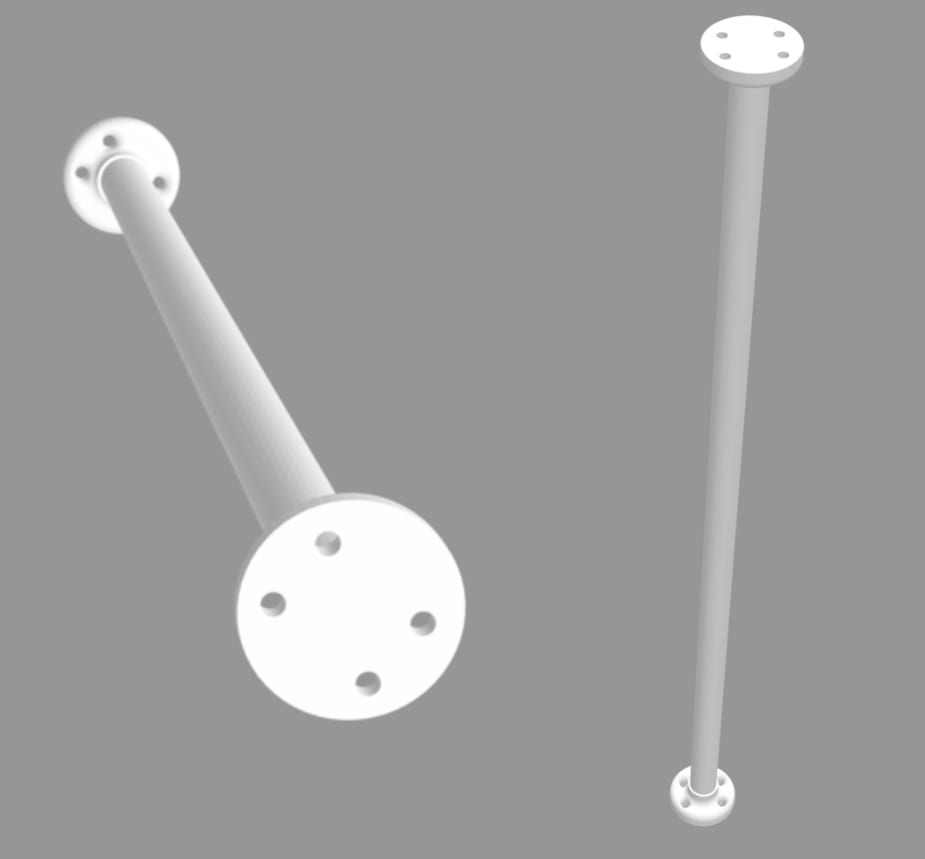
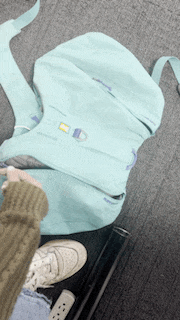
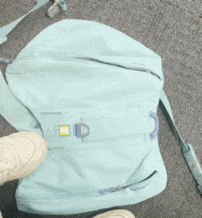
Black Bag
While waiting for the new materials (magnetic strips, handles, and hooks) the team created this visual protoype of what the final product may look like along with the dispoz-a-scoop. The diagram below shows how the dispoz-a-scoop would be attached by the hook sewn on the saddle bag (placement to be determined). A handle would be added to outside of the tote so Jessica can easily break the magnetic force along the opening of the bag with her foot. The magnetic strips not shown will be sewn into the seam along the edge of the bag opening.
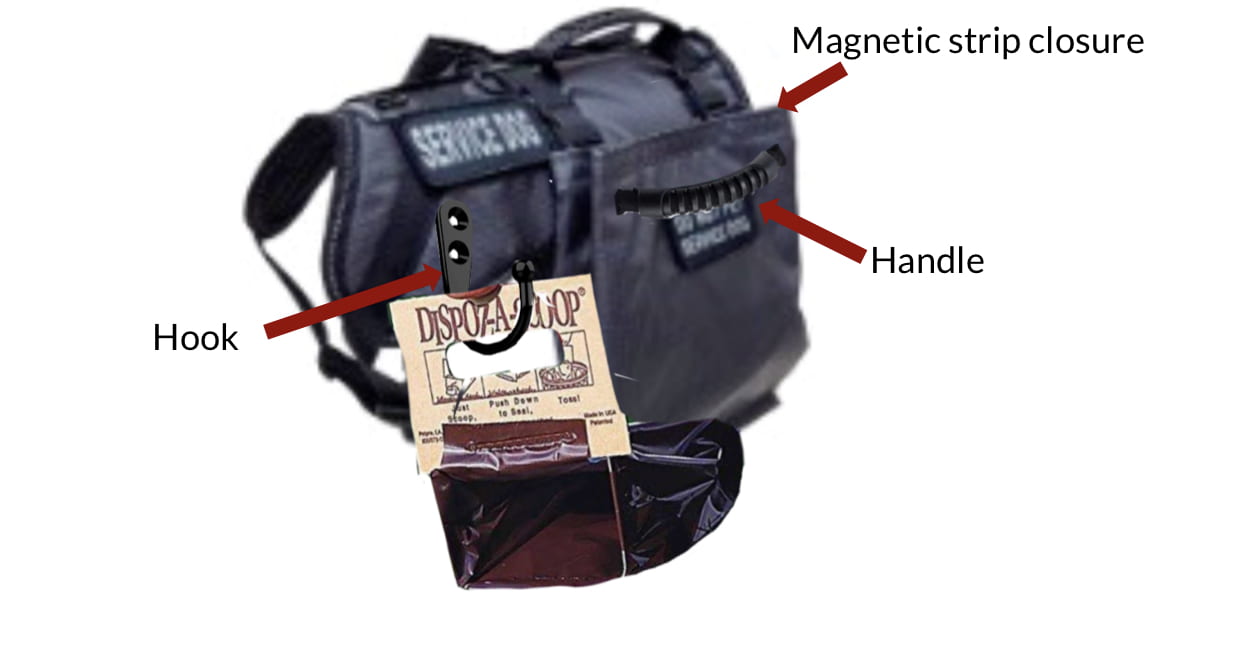
Selena’s FIRST Meeting with Daniel: 12.15.22
During this meeting Daniel, NYU’s Interactive Telecommunications Program (ITP) Resident with experience in fashion and sewing, and Selena created a prototype of the adaptations to be made on the black saddle bag totes. Selena also learned and practiced the basics of using a sewing machine. Before creating the prototype we discussed how feasible it would be to place the magnet strips inside the seam of the tote bags. We discovered that there was enough fabric to securely insert the magnet. Since we realized that there would be three layers that would fold over the magnet, we tested the force of the magnet to ensure that it would be strong enough to hold the two sides together when the tote bag is closed:
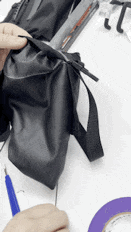
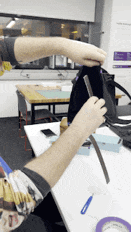
Below are the steps to creating the prototype
Step 1: Remove handles and break the seam of the bag using a seam ripper tool
Step 2: Place the magnet strip ensuring that the magnet side (not the adhesive side) will face the other side of the bag where the second magnet would be. Leave 3/8ths of an inch of fabric below the magnet to have enough space for the stitching.
Step 3: With a sewing maching, re-sew the seam and the edge of the magnet
Step 4: Stitch on both ends of the handles
*First test* After sewing on the magnet and handle we tested opening the bag using lower limbs. Unfortunately, the magnet force was too strong and the handle ripped off.
Step 5: Reinforced the handles by stitching extra fabric to disperse the force when opening the bag and prevent handle from ripping off. Used a zig zag stitch on the fabric and re-stitched the handles.
*Test #2* Successful attempt at opening and closing the bag with lower limb after reinforcing the handle
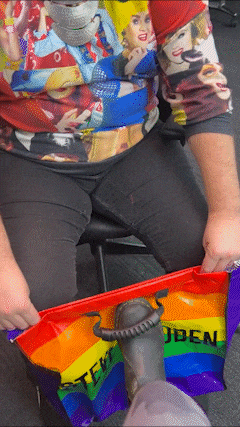
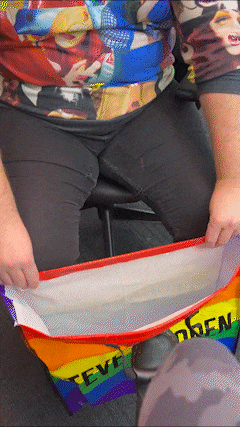
Some Key Takeways:
Follow up points with Jessica:
- Flaps and handles: to remove or velcro down (might be useful for Patrick)?
- Hooks
- Double prongs for stability or one prong for easy manueverability?
- Angling the hook upwards and placing it higher up on Chewie will decrease the chance of the dispozascoop falling. Can you get your foot up and maneuver an upwards angle?
- Placement of the hook will be discussed once the magnets and and handles are on
- Security of the handle staying attached when pulling open the magnet because the force of the magnet is very strong
-
- Possible solutions:
- Chicago screw, rivet, and washers to reinforce handle
- Adding extra fabric
- Can Chewie learn to pull as you pull to break the force of the magnet?
- Instead of pulling straight out, manuever foot to break one end of the magnet then the other
- Cutting magnet in half lengthwise
- Possible solutions:
-
The following tests were performed to help visualize the force of the magnet:
Upside-down Test: Placed two pens, chapstick, deoderant, and wallet in prototype bag and shook it upside down forcefully to ensure that the magnets are strong enough to keep all items in the bag.
Breaking force of the magnet pulling straight out: Medium to strong
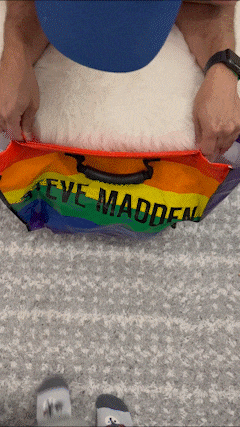
Breaking force of the magnet against another pulling force: Medium
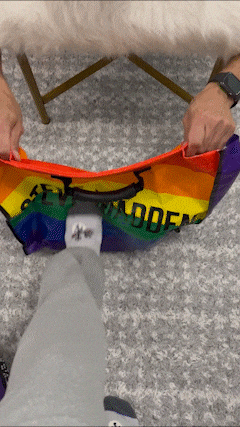
Breaking force of the magnet breaking one end at a time: Easy
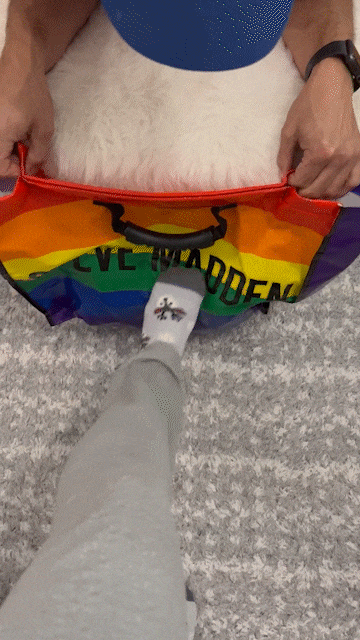
Breaking force of the magnet simulating cutting it in half: Too easy
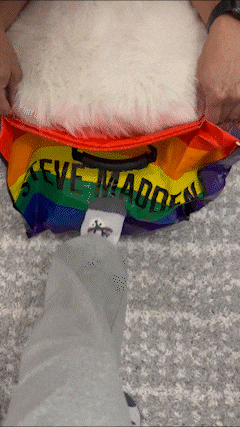
Weekly Update 8: 12/6/22 (Prototyping UpDATES)
The team has primarily been working on addressing the issue with opening Chewie’s bag. To make it easier for Jessica to open the bag, the team has been working on a couple of solutions as mentioned in previous updates: (1) Modify the black bag to use magnetic snaps, (2) Modify teal bag to increase rigidity across the zipper.
Hook for Dispoz-A-Scoop:
Sophie Ana prototyped some carabiner solutions to work as the hook for Dispoz-A-Scoop. She also 3D printed a prototype. However, the printed solution didn’t work that well because of rigidity issues. Later, the team discussed other possible solutions for the hook and decided on exploring a commercial solution (pictured below) that Jessica could have access to if a replacement is needed. Since there was an issue with attaching the hook onto the bag with carabiner (it’s flimsiness making operating it a two-limb task), the team is considering sewing a hook directly to the bag so that it is firmly attached.
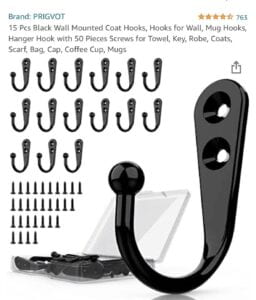
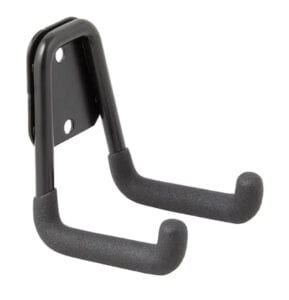
Teal Bag:
Meanwhile, Sophie received the teal bag from Jessica. She took measurements of the bag and worked on the 3D printed zipper frame prototype, discussed previously to make the zipper more rigid. However, the printed solution didn’t work that well because of printing errors. Sophie is continuing to try to desing and print a different version.
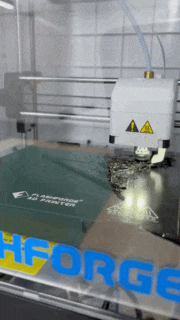
Black Bag:
For the black bag, the team has been trying out adding magnetic snaps to a flap that would go over the bag. This would prevent any items small or large from falling out of the bag. The team developed a prototype using magnetic snaps. However, we realized that using magnetic snaps would require some precision. Althought, Jessica stated this type of close has worked for her in the past we want to make this process as seamless as possible. Therefore, the team continued looking for other solutions. One solution that the team is actively pursuing is sewing magnet strips directly into the bag so that it doesn’t require precision like in magnetic snaps.
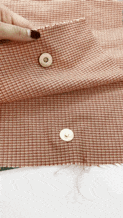
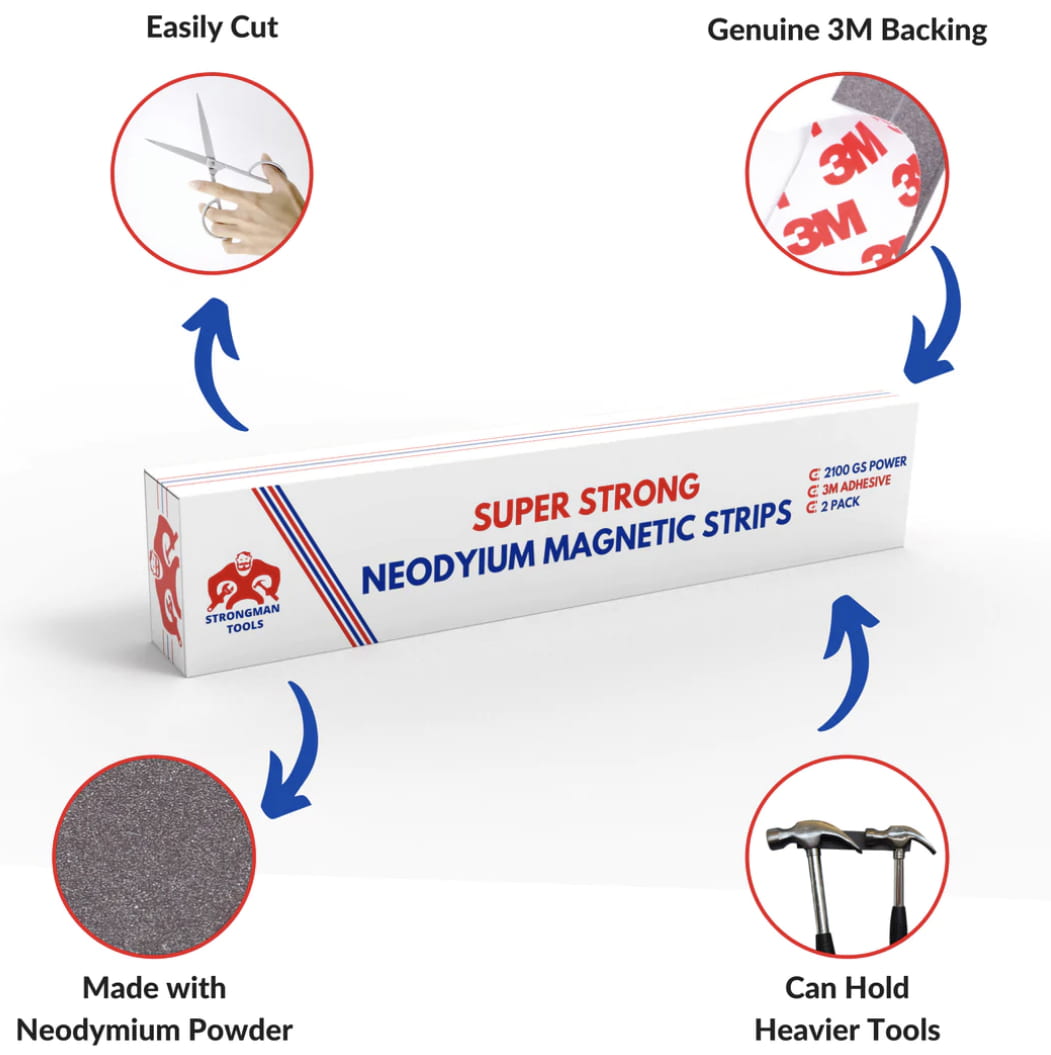
Weekly Update 7: 11/29/22 (Meeting 5 collaborative design framework 2)
MEETING 5 with Jessica: 11.30.22
During our fifth meeting with Jessica we conducted the second Design Framework meeting focused on collaborating on possible solutions for Chewie’s saddle bag. The two main issues with the current saddle bags are:
- Black Service Dog Saddle Bag: Only one velcro closure in the middle of the tote that leaves gaps on both ends of the bags through which small items can fall out as Chewie moves around. Additionally velcro wears over time, which is the case with the current bag and needs replacing.
- Teal Saddle Bag: Zipper is not rigid enough to be able to be manipulated with one foot. Jessica would have to use two feet to hold one end with one foot and use the other foot to open/close the zipper. In order to do this she would have to sit on the ground.
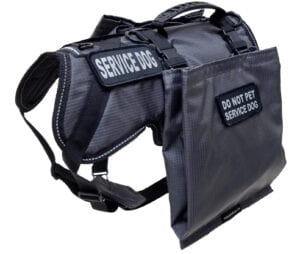
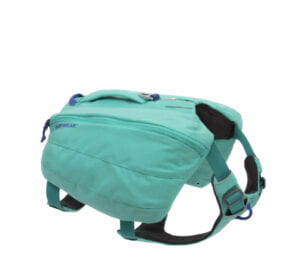
We narrowed down possible solutions with Jessica (1) Add accessible closures to black saddle bag (2) Adapt current zipper on teal saddle bag to increase rigidity. The team will begin to create and deliver protoypes this week. Below are details from the meeting.
Dispoz-a-scoop update
- Jessica tried attaching the Dispoz-a-scoop to the black service dog saddle bag with an over door hook to no avail. The bag was not rigid enough to securely attach the hook, which was too heavy.
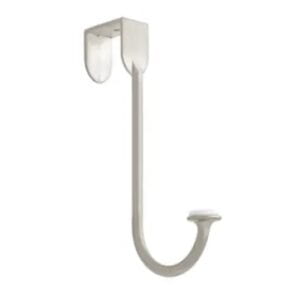
- Jessica also tried a carabiner which was difficult to manipulate since she would need both feet to push open the hook and to be able to attach it to the saddle bag. She would have to sit on the ground to perform this task, which she expressed she would not like to do.
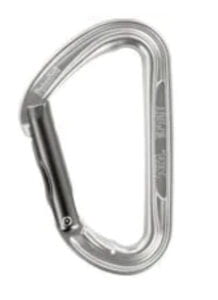
- Jessica likes the idea of having a hook secured permanently on the bag that she doesn’t have to attach and reattach. The team will continue to look for more options. Sophie Ana suggested 3D printing a customized solution, which will be explored in the coming weeks.
- Addressing affordability: Since the Dispoz-a-scoop is a disposable product that needs to be replenished, the team recognizes that this is a costly expense for Jessica. She suggested that she could reach out to the company to partner with her foundation in order to get a discount for herself and any other individual who may find this product helpful. Safal will send an initial email putting Jessica in contact with the company in order to set this up. Because Jessica’s foundation is a non-profit this could incentivize the company to be able to provide a discount using the 501(c) 3 tax write-off.
Solutions from the Design Framework
- Closure Solutions: Jessica stated that the closures which have worked the most in the past were magnetic snaps. The current closure mechanism, being a worn-out velcro piece in the middle of the black bag, is not enough to keep items safely in the bag. Adding more velcro is not the most viable solution because it would require more surface area that Jessica would need to manipulate to open/close the bag. Replacing the velcro closure with a magnetic snap will make it easier for Jessica to open/close with one foot. However, it will not fix the issue of leaving exposed parts of the bag. Therefore the team will look into adding a flap that will completely cover the bag opening with a magnetic snap that Jessica can easily use.
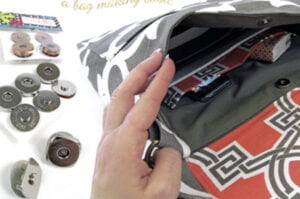
- Zipper Adaptation: To address the zipper issue with the teal bag, Jessica liked Sophie Ana’s prototype sketches of a 3D printed frame that would line the zipper to provide more rigidity to the zipper when opening and closing the bag.
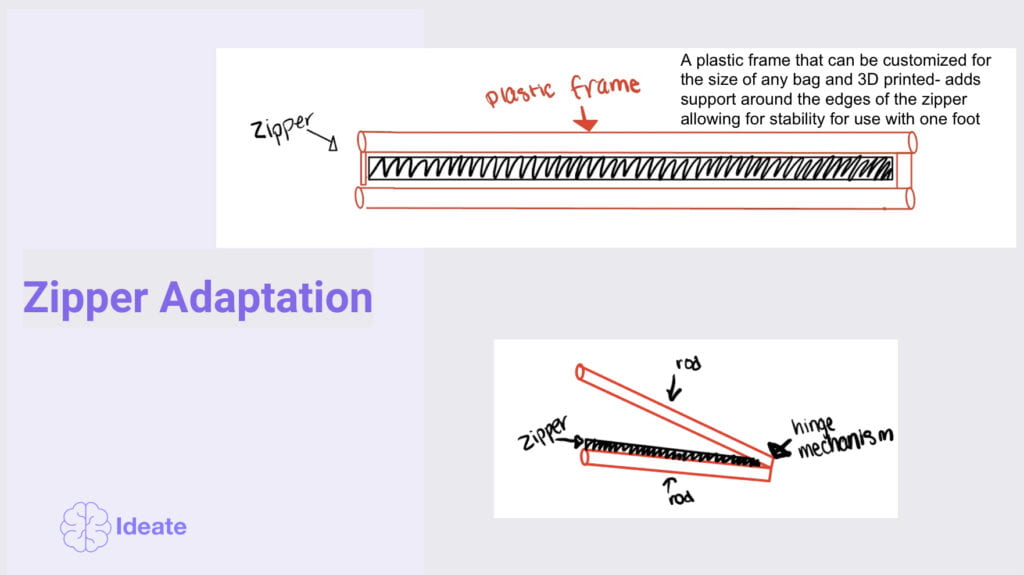
Other points to consider
- Purse organizers: to decrease the chance of small items falling out of the black saddle bag, Jessica suggested adding a purse organizer insert inside of the black bag shown below
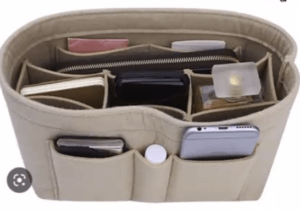
- Any adaptations cannot surpass 25% of Chewie’s body weight of 65lbs
Action items
- Safal will email Dispoz-a-scoop
- Jessica will send Sophie Ana the teal saddle bag and Selena the black saddle bag to make adaptations to
- Sophie Ana will 3D print hook solution for attaching Dispoz-a-scoop and zipper solutions for teal saddle bag
- Selena and Izzy will make adaptions to black bag using magnetic snaps
- Erika will research bag organzier inserts
- All team members will work on final presentation
Weekly Update 6: 11/22/22 (New Project Goal: Accessible saddle bag)
- Exploring other bags that have rigid zippers such as thermal lunch boxes or bucket purses
- Adapting the zipper on her current teal bag to make it more rigid
- Exploring other closures: magnets, velcro dots, turn and locks etc.
Weekly Update 5: 11/15/22 (meeting 4 Major breakthrough)
MEETING 4 with Jessica: 11.11.22
On Nov 11, 2022, the team met with Jessica and Patrick to discuss the product, Dispoz-a-scoop. We learned about Dispoz-a-scoop during our initial competitive analysis on Week 2. In the coming weeks, we presented the solution to Jessica, and recently, she sent us a video of her trying it out (DropBox link to videos provided by Jessica). In the recent meeting with Jessica and Patrick, we were able to gather feedback on Dispoz-a-scoop as a potential solution for their problem of picking up Chewie’s poop.
Jessica hadn’t heard about Dispoz-a-scoop before our presentation. After trying it out, she shared how much she liked the product. She liked it because she wouldn’t have to tie a knot to close the bag after using it. She can simply press near the opening to close it. The handle of the bag made it easier for her to handle it with her feet. She also mentioned how the handle would help her to open a trash can with a lid without touching it. Jessica is excited about Dispoz-a-scoop and wants to reach out to the company to potentially partner with them to provide people with limb difference with a service dog a discount on the product. Currently, the price of a single Dispoz-a-scoop is quite expensive for it to be sustainable for everyone. A partnership might permit a lot more people with limb difference to use it.
Initially, she had difficulty carrying the bag to the trash can after using it. However, she later realized that she could hang the bag on a hook with help of the tiny flap on the handle. The team had been discussing the exact issue earlier this week. We discussed some potential solutions for a hook in a brainstorming session. We shared our jamboard with her, and she liked the concept and was interested in further exploring it.
We discussed how having a hook on Chewie’s saddle bag might be a good idea to hang the Dispoz-a-scoop bag after use.
Video: Jessica trying Dispoz-a-scoop
Along with the discussion on Dispoz-a-scoop, we discussed modifications for Chewie’s saddle bag. At the start of the semester, Jessica described how she was having difficulty using the zipper mechanism on Chewie’s bag. We discussed some possible solutions with the team earlier this week. During the meeting we asked Jessica what exactly about the current bag made it harder for her to zip it. She answered that Chewie’s bag isn’t rigid enough, so it collapses. We asked if she had tried a larger loop on the zipper like a zipper extension. She replied that the same problem persisted with the zipper extension as well, and she still couldn’t slide the zipper.
After discussing with Jessica, we realized that as long as the rigidity of the bag doesn’t make Chewie’s bag heavier, we could change the bag to something that has rigidity on both sides of the zipper. Bucket bag/purses are a good reference to the potential solution as they are easier to open and see what’s inside. We also discussed some alternative closing mechanisms like Flaps, velcro, or magnet with Jessica and Patrick. They liked the idea and are interested in figuring out solutions with these mechanisms.
Until the next meeting, Jessica and Patrick will be trying to attach a hook to Chewie’s bag and let us know how it goes. Meanwhile, the team is planning to discuss further on modifications to Chewie’s bag or finding other alternatives.
Weekly Update 4: 11/8/22 (Student team meeting + Next steps)
During our weekly meeting, we decided on the following points for next steps:
- Next goal for team meeting on Nov 8, 2022
- Iterate on Dispoz-a-scoop
- Find other solutions which Patrick mentioned during the last meeting – the shoe attachment, the stepping mechanism
- Explore Jessica’s videos on her social media account focusing on how she uses her limbs to manage things around.
- Follow-up questions for Jessica
- What kind of shoes does Jessica wear while walking Chewy?
- How does she envision disposing of the Chewy’s litter or managing the trash can?
Weekly Update 3: 11/01/22 (Meeting 3 Collaborative Design Framework 1)
MEETING 3 with Jessica: 10.28.22
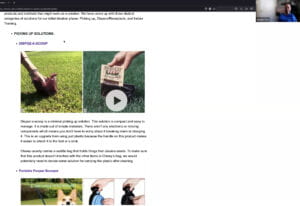
The purpose of our third meeting on October 28, 2022 with Jessica was to carry out the Design Framework. We shared with our slide deck in advance and ideated on the pre-existing solutions in the market (mentioned below in weekly update 2). Below are some of Jessica’s thoughts.
What do you currently use?
- Chewie goes in the yard. Patrick uses the metal tray and rake to pick up. He goes out there and picks it up periodically. The training bag also has a dispenser for plastic bag which Patrick uses to pick up and throw away. Jessica would use the plastic bags when Chewy was small.
- Jessica just uses her feet and toes
Discussing possible solutions
- Dispoz-a-scoop: Jess likes it a lot. She can use her toes to grab it and use it to pick it up. They ordered a pack and sent a video for feedback. Dispoz-a-scoop is good, but it picks up the rocks too.
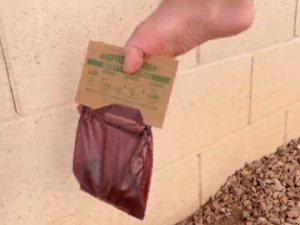
- Portable Pooper Scooper: They have this already. The problem was that the clip was too wide for her foot. She likes the convenience of the bags, but the grip was too big for her. She would want a smaller grip because she uses the the distance between her big toe and second toe to pinch. It would be a process to put the plastic and sit on the ground and clip it with two feet. She would prefer putting the plastic at home, then go use the product.
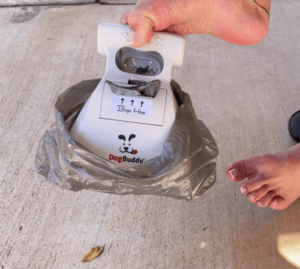
- Doody Bag: She would balance on one leg and use it. She doesn’t think it would work because of the length. Might work if it is like her car vacuum’s size, around a half or a third of this size.
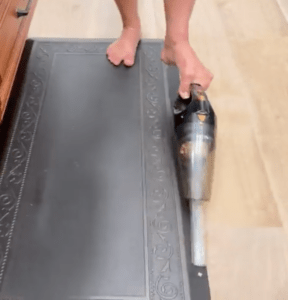
- GoGo Stik, Grab-n-gone, Bag it Dog, Hands-free poop collector,Collapsible Receptacle, Disposable pet diaper, potty pads: Need two hands, Chewie doesn’t like it, etc. Don’t work/like for one reason or another.
- Jess wants a very minimal contact method that would help her dispose of Chewy’s waste. She uses her chin and shoulder to carry a bag to carry stuff and throw it. She can hold it between her toes or drag it if the thing is gross.
Future Plans:
- Dispoz-a-scoop stood out the most. Scooping is the most easy for her. It also requires minimal contact. This is also compact enough that it can fit in Chewy’s pouches instead of carrying a stick or any pooper scooper. However, she needs to try it out before deciding it. We may need to make it bigger. The card board face when you push down it closes up. We may need to change up the mechanics a little bit. She’ll send us a video of how it works out.
- Patrick suggested: A device that Jessica puts over her waist. Setting on the ground and stepping on something; adapt some mechanisms that we showed. Maybe a lacrosse handle cut off and attached to shoe. Something that’s attachable to the shoe later. Scoop with the attachment. Put the attachment back to Chewy’s pouch. Jessica used a modified lacrosse stick to play PE as a kid.
Actions:
- We are looking into all the products Jess has used. We have purchased Dispoz-a-scoop scoopers to prototype, as it seemed them most viable option.
Weekly Update 2: 10/25/22 (Competitive Analysis + Meeting 2)
Meeting 2 with Jessica: 10.10.22
Jess and Patrick are traveling! They are currently in Atlanta. During our meeting, we decided on the team name “The Right Foot for Chewie.” Here are some follow up questions we discussed:
What’s Chewie’s personality like?
- Chewie is a very chill dog. Relaxed, swimmer, loving. He loves to jump in the pool. He loves to walk and snuggles, but he also likes to have a purpose and he takes his job very seriously. He is only 2 years old.
- Hates vacuum, airplanes
What do you usually put in the bag?
- Portable Dressing hook, wallet, car keys, a bag for dog treat, a poop bag, straw (her plane did not have a straw today but it’s a must), and other things you usually find in a purse
- Currently they are using the following bags:
- https://ruffwear.com/products/front-range-day-pack
- The colored one keeps it secured, the bag will flax and change shape.
- https://activedogs.com/service-dog-grocery-getter-harness
- But everything falls out
- https://ruffwear.com/products/front-range-day-pack
Her ideal bag could be like:
- Fashionable bag, but professional, with multiple compartments (most of the bags she purchased only has one compartment), cross body bags with a quick access, small pocket on the exterior of the big compartment to easily access ID/key, easy to put on
- Add an attachment to the saddle bag
- Add some key chains to it to attach carabiner or telescoping straw for easy access
- Prioritizing functionality along with fashion
Out of the two prompts, which is most urgent to solve?
- (1) Chewie’s waste (she used to sit on the ground and pick up the poop with both of her feet but now it’s too big and she doesn’t like sitting on the ground)
- (2) Chewie’s bag
- (3) Hair binder
Competitive Analysis
INTRODUCTION
Jessica Cox is a pilot, taekwondo blackbelt, entrepreneur, and motivational speaker who was born with no arms, often referred to as congenital limb difference (CLD). While growing up, Jessica used prosthetic limbs for 11 years after significant practice during therapy sessions. However, Jessica decided to stop using her prosthetics as she preferred doing daily activities with her feet and embrace what makes her different.
There is extensive research on the use or non-use of prosthetic limbs for children with congenital limb differences (CLDs). Based on a literature review, rejection and non use of prostheses was observed in approximately 1 out of 5 individuals with upper limb differences (Biddiss & Chau, 2007). Factors related to the abandonment of prostheses include, but are not limited to functionality, durability, appearance, comfort, and usability (Biddiss & Chau, 2007). Additionally, prosthesis use is notoriously difficult for activities of daily living involving hygiene, eating, grooming and dressing (Biddiss & Chau, 2007). In Johansen et al. study (2016) of children with upper CLDs, similar to Jessica, it was found that most children manage well in everyday life as compared to children born with upper limbs. While 26% of these children used prostheses, 54% used grip improving devices instead (Johansen et al., 2016). Prosthetic adaptation for children is challenging for many reasons, one being that children are constantly developing. However, most children with upper limb differences manage well without prosthesis as grip improving devices can be custom made or adapted for specific activity (Johansen et al., 2016).
On the other hand, one study reveals a positive correlation between the number of activities that the children performed more effectively with their prosthesis and the daily use duration (Mano et al., 2021). This suggests that being able to perform everyday activities more effectively with their prostheses may motivate children to wear it longer. Therefore, to ensure that children become accustomed to wearing their prostheses, the prostheses should meet the requirements of everyday activities (Mano et al., 2021). However, it was also found that children with upper limb differences perform approximately 30% and 20% of the items more effectively without and with the prosthesis, respectively (Mano et al., 2021). Generally, assistive devices can benefit those with functional impairments; however, the scientific evidence is not sufficient to draw strong conclusions regarding the effectiveness of prosthetic interventions (Mano et al., 2021).
In a survey 89% non prosthetic users felt that they were simply more functional without prosthesis (Biddiss & Chau, 2007), which we can safely assume Jessica felt similarly. Research on the brain’s neuroplasticity offers support to the sentiments of these individuals. Dempsey-Jones et al. (2019) studied the fMRI scans of two professional foot painters born without hands, who also use their feet for every day tasks, and compared them with the scans of a control group of 21 people born with two hands. These researchers observed somatotopic maps, which are specific parts of the body that match up with specific parts of the brain. They found that in the foot painters group, the area of the brain that corresponds with the toes was that same area that usually manages the hands; showing that the brain’s hand area can support body parts compensating for a disability (Dempsey-Jones et al., 2019). Additionally, it was found that each toe of the foot painters were individually mapped, just like each individual finger of the hand is usually mapped (Dempsey-Jones et al., 2019). This distinction of the toes does not usually occur in the brain’s somatotopic maps, unless there is constant use of the feet for complicated, dexterous tasks like climbing (Dempsey-Jones et al., 2019). The brain’s ability to reorganize itself according to people’s varying experiences is called neuroplasticity, which shows an inherent resiliency of the brain and body.
Based on this research, our team feels strongly that our solution, to be created alongside Jessica, should (1) meet the requirements of the task and, (2) should empower Jessica to use her differences as strengths to accomplish everyday tasks independently. Jessica is looking for a solution to clean up after her dog, Chewy, when she is walking him outside and needs to relieve himself. This is difficult for Jessica because she has no arms to pick anything up, and it is difficult for her to clean up after her dog just using her feet. In most cases, Jessica has to ask her husband or a neighbor to clean up after her. This is inconvenient and impractical, and she needs a solution to help her independently pick up after her dog.
COMMERCIALLY AVAILABLE PRODUCTS
After some discussion with Jessica and the team, we researched some commercially available products and methods that might work as a solution. We have come up with three distinct categories of solutions for our initial ideation phase: Picking up, Diapers/Receptacle, and Indoor Training.
- PICKING UP SOLUTIONS:
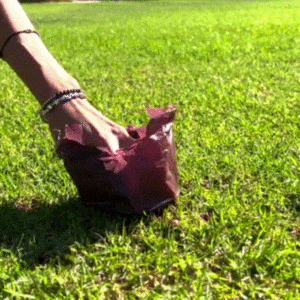
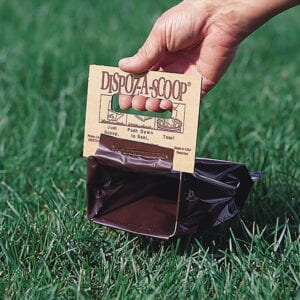
Dispoz-a-scoop is a minimal picking up solution. This solution is compact and easy to manage. It is made out of simple materials. There aren’t any electronic or moving components which means you don’t have to worry about it breaking down or charging it. This is an upgrade from using just plastic because the handle on this product makes it easier to attach it to the feet or a stick.
Chewy usually carries a saddle bag that holds things that Jessica needs. To make sure that this product doesn’t interfere with the other items in Chewy’s bag, we would potentially need to devise some solution for carrying the plastic after cleaning.
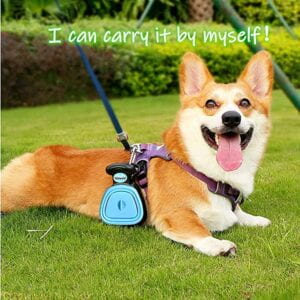
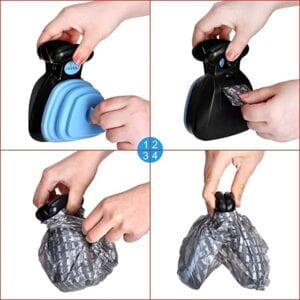
This device is a portable pooper scooper option that can be adapted to be attached to Chewy’s saddle bag for walks. Additionally the squeezing mechanism may have to be further assessed to determine if Jessica would be able to do this with her feet. If this is not the case, a handle may need to be added that can be accessible for her feet. Lastly the bagging component may need to be set up with assistance prior to leaving for the walk, or also adapted so that Jessica may be able to use this device independently.
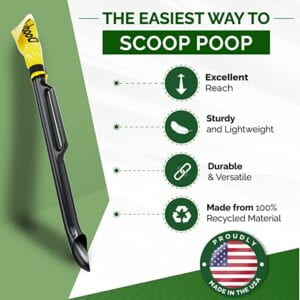
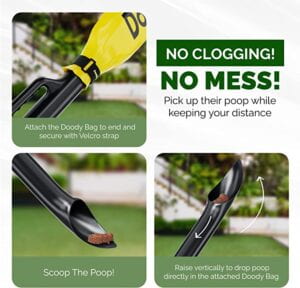
The “Doody Bag” could also be used by Jessica if she uses her feet to hold the product. It does require the insertion of the disposable bag every time it is used, which most likely would be difficult for Jessica to do herself, meaning someone would probably need to help her.
Jessica wants the product to be smaller to fit in or around Chewy’s saddle bag, so this product will work if we manage to find or make a smaller version that is usable with the feet and easy to attach to Chewy’s bag.
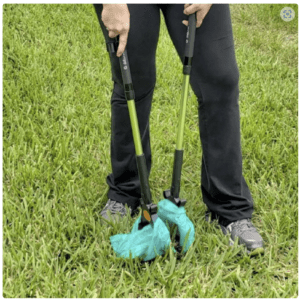
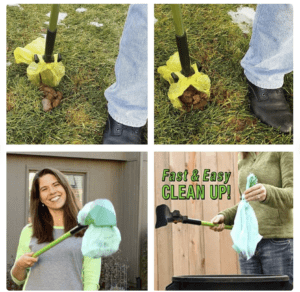
This is another picking-up solution that uses two sticks: one for holding and the other for scooping. It can be modified for Jessica to use with her feet. One possible way may be to make one side stick into the grass. Another approach could be attaching the two sticks like a pair of tweezers so you don’t need both feet at the same time to use the product.
One limitation is that this product needs to be set up before you leave the house. It would be difficult to put on the plastic outside. The other limitation that needs to be factored in is that the item is too large. To handle the product easily and so that Chewy can carry it, a smaller version might be helpful. In this version, one foot could be used to hold one of the sticks perpendicular while the other feet can drive the scooper independently.
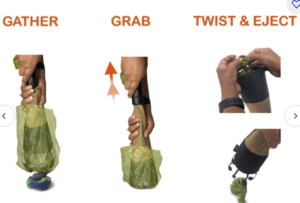
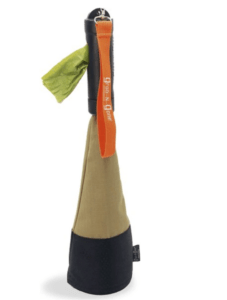
This product is a compact solution to our problem. You can load a bag and pull one end of the device to scoop and enclose automatically. The primary use of this product is mainly two-handed, but we could modify it to work for Jessica.
Currently, the body of the product is too weak and you have to hold it with your hand to pop the handle in or out. We could make a handle or attachment to grab the body of this product with your feet easily. Another approach could be to make a sturdier body for the product which is easy to hold on to.
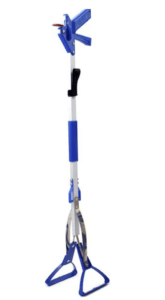
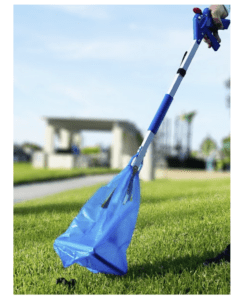
The Bag It Dog Pooper Scooper differs from other scooper solutions, as it has a very long handle to reach the ground from standing height, and it only requires one hand (or any body part) to use, as opposed to needing two, such as the EZ Clean Scoop. This product could allow Jessica to pick up after her dog by controlling the mechanism that would be slightly adapted for her feet. The fact that the device can be handled with one limb means Jessica may be able to stand when using it.
- DIAPER/RECEPTACLE SOLUTIONS
Rather than centering the goal of the solution for Jessica to be a way to grab the dog’s waste without using hands or arms as is the case with the products listed above, other solutions can simply eliminate the issue of having to pick up the dog poop in the first place, allowing Jessica to not have to worry about picking up after her dog.
![]()
This clip-on bag eliminates the issue of having to pick up the poop from the ground. By attaching this bag to the dog’s tail, the waste never ends up on the ground; it just goes directly into the bag, meaning nothing has to be cleaned up or picked up.
This product is easy to use, but it will have to be tried and tested. We need to factor in two points. Firstly, Jessica needs to be able to clip and unclip the device onto Chewy. Secondly, Chewy should not feel uncomfortable wearing the device. These two points can impact the usability of the device and modifications might have to be made.
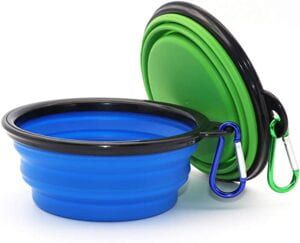
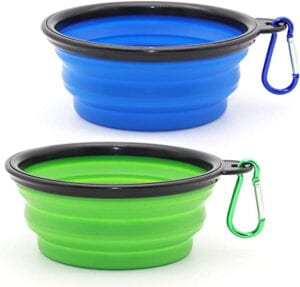
This collapsible feeding bowl can be converted into a portable bucket that can be used to train Chewy to go in. The bowl has a key chain holder, which may need to be trialed and adapted so that Jessica is able to manage this attachment mechanism with her feet and put it on Chewy’s saddle bag. Additionally the bowl may need to have a bag wrapped around the bowl to make this solution more sanitary and easily cleaned. Having the added element of the bag raises the question of how Jessica would be able to manage the bag and dispose of it with her feet.
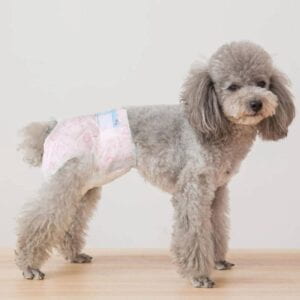
Putting a “doggy diaper” on Jessica’s dog provides a very similar purpose as the clip-on bag above. The diaper option seems like it would be harder for Jessica to put on and take off her dog, since there are flaps that are attached, requiring multiple steps. This solution still eliminates the problem, however, of having to pick up the dog’s poop from the ground.
- INDOOR TRAINING
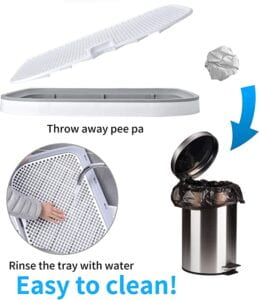
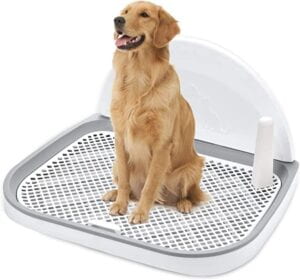
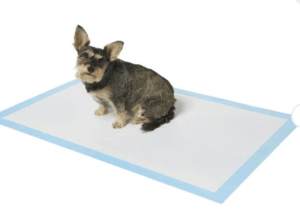
- OTHER ALTERNATIVES
Alternative solutions could include the many types of mats and “dog-potty” products that are sold. There is a very large variety of these types of toilets for dogs, some portable, some more permanent, all with varying costs. In order for these products to be useful for Jessica, her dog would have to be trained to only relieve himself on the pad, which can be placed in Jessica’s house. This would allow Jessica to take her dog on walks just to walk, not for the purpose of the dog relieving himself, eliminating the need to let the dog out to have him relieve himself. While this may be an alternative ideal for home use, Jessica would still need an additional solution when they are traveling with Chewy.
REFLECTION
We have proposed three different kinds of solutions: Picking up products, Diapers/Receptacle, and Indoor Training. These products can be on Jessica’s end where she’s taking care of cleaning up or she’s using semi-self managed products like diapers. They can also be on Chewy’s end where they get some dog training to always use a potty-pad to relieve themselves. At the moment, Jessica is not using any products for this problem. She usually has to ask her spouse or neighbor to go clean up after she has come back from a walk. Our solutions would potentially help her become independent in the matter of cleaning up.
Some solutions, especially the products for picking up, are geared towards users with hands. Therefore, these products might not transition easily to Jessica’s use case. Along with usability with feet, another crucial design need is compactness. Jessica needs to be able to use Chewy’s saddle bag to carry the device. Moreover, after she cleans up, she needs to be able to store it without having to put it inside her bag with her other items. Hence, some additional considerations are necessary for handling the device and the bags used for cleaning up as well. We are looking into making the product compact and attachable to Chewy’s bag to solve the above-mentioned problems.
Additionally, dog training might require Jessica to change up her routine a bit. She will have to invest time in dog training and manage appointments. However, if she does find this approach interesting and finds the time, it could be a good solution to the current problem.
References
- Biddiss, E. A., & Chau, T. T. (2007). Upper limb prosthesis use and abandonment: a survey of the last 25 years. Prosthetics and orthotics international, 31(3), 236–257. https://doi.org/10.1080/03093640600994581
- Dempsey-Jones, H., Wesselink, D. B., Friedman, J., & Makin, T. R. (2019). Organized Toe Maps in Extreme Foot Users. Cell reports, 28(11), 2748–2756.e4. https://doi.org/10.1016/j.celrep.2019.08.027
- Johansen, H., Dammann, B., Øinæs Andersen, L., & Andresen, I. L. (2016). Children with congenital limb deficiency in Norway: issues related to school life and health-related quality of life. A cross-sectional study. Disability and rehabilitation, 38(18), 1803–1810. https://doi.org/10.3109/09638288.2015.1107770
- Mano, H., Noguchi, S., Fujiwara, S., & Haga, N. (2021). Relationship between degree of disability, usefulness of assistive devices, and daily use duration: an investigation in children with congenital upper limb deficiencies who use upper limb prostheses. Assistive technology : the official journal of RESNA, 1–6. Advance online publication. https://doi.org/10.1080/10400435.2021.1970652
Weekly Update 1: 10/18/22 (Goals + Meeting 1)
- Team Name: The Right Foot for Chewy
- Select the student who will be the main point of contact for the group to schedule meetings, and manage email : Chitvan Bindal
- Overview of team member responsibilities:
- Schedule for regular meetings throughout the semester: Tuesday class time
- Description of the project: Jessica was born with no arms due to a rare congenital limb difference. She’s an airline pilot, a motivational speaker, and a taekwondo blackbelt. Currently, she and her husband, Patrick, are looking for solutions to a few problems that Jessica has, mainly 1) picking up Chewie (their dog)’s poop, carrying it to a trash can and disposing of it and 2) easily opening and closing pockets on Chewie’s saddle bag and having quick access to some of Jessica’s needed items (like an extendable straw or a portable dressing hook).
- What tools/expertise will you leverage to complete the project? Having an occupational therapy student on the design team will offer a clinical perspective and knowledge of assistive technologies that could help people with limb differences. Additionally, we will leverage Selena’s OT background to ensure that we have the most functional solution for Jessica throughout the design process. Depending on the solutions we brainstorm with Jessica, we may also utilize NYU’s Makerspace, as we’ve all received introductory training.
- What additional tools / expertise will you need to complete the project? This is to be determined after our brainstorming meeting with Jessica.
- What is your timeline?
- 10/24: Competitive Analysis
- 10/28: Design Framework activity with Jessica
- 11/1: Prototyping
- Midterm Presentation
- 11/7: Trial 1 with Jessica
- 11/7 and on: Continue to trial/evaluate prototypes until delivering final product
Note: We’ll repeat the process if we manage to deliver for our first project early (accessible dog pooper scooper). We’ll plan out a new timeline for other projects (accessible bag).
Meeting 1: 9.29.22
First Meeting with Jessica and Patrick! So exciting!
We did some introductions and then dove right in.
Jess is a mover, an entrepreneur, a creative. Learning how to be confident despite her challenges was one of her biggest difficulties growing up. She stands on one foot (right foot) to multitask.
Main Challenges:
- Shopping, grabbing things out of the bag while paying
- No opposable thumbs but can extend toe
- Grabbing larger things is a challenge
- Biggest problems are picking up after Chewie and accessing Chewie’s saddle bag
How are you managing the problems right now?
- Used to be able to do it with feet when his poop was smaller
- Leaves fanny back bag open because its hard to open (you need one hand to hold and one to close to zipper), Jessica’s phone and other things spill when Chewie lays down in the car
- Keys, cell phone, Chewie’s treats/water bowl, hook credit cards, miscellaneous, straws, etc. in the bag
Typical day:
- Morning routine
- Breakfast usually likes cereal
- Home office
- Walk early in the morning with Chewy (runner’s belt as leash)
- Tae kwon do
- Evening walk (Chewie goes in the neighbors yard)
During our next meeting, we intend to discuss her experience with the Dispoz-a-scoop and henceforth, decide the next steps.